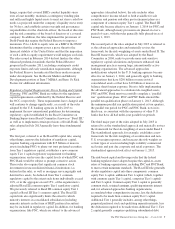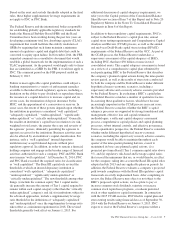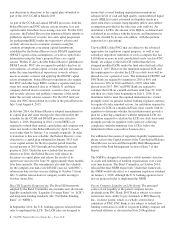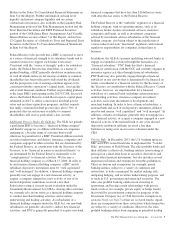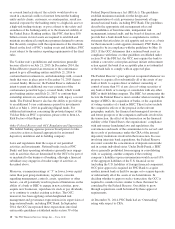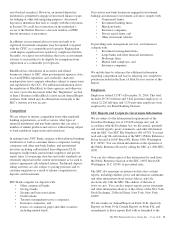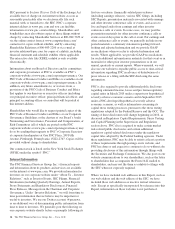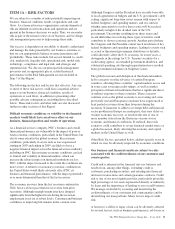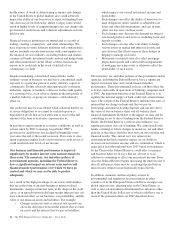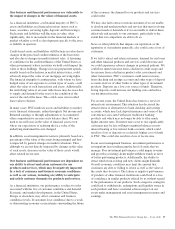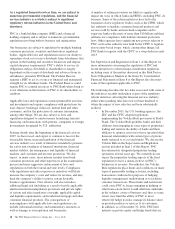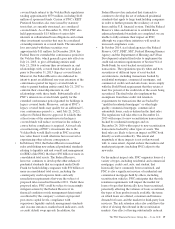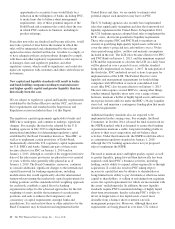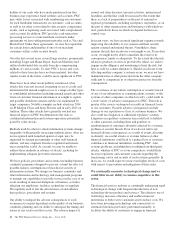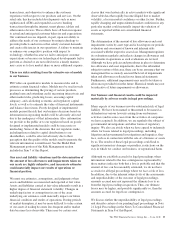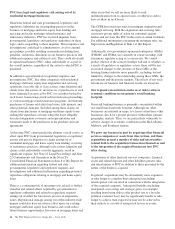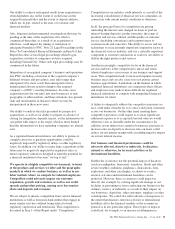PNC Bank 2014 Annual Report Download - page 33
Download and view the complete annual report
Please find page 33 of the 2014 PNC Bank annual report below. You can navigate through the pages in the report by either clicking on the pages listed below, or by using the keyword search tool below to find specific information within the annual report.ITEM 1A – RISK FACTORS
We are subject to a number of risks potentially impacting our
business, financial condition, results of operations and cash
flows. As a financial services organization, certain elements of
risk are inherent in our transactions and operations and are
present in the business decisions we make. Thus, we encounter
risk as part of the normal course of our business, and we design
risk management processes to help manage these risks.
Our success is dependent on our ability to identify, understand
and manage the risks presented by our business activities so
that we can appropriately balance revenue generation and
profitability. These risks include, but are not limited to, credit
risk, market risk, liquidity risk, operational risk, model risk,
technology, compliance and legal risk, and strategic and
reputation risk. We discuss our principal risk management
processes and, in appropriate places, related historical
performance in the Risk Management section included in
Item 7 of this Report.
The following are the key risk factors that affect us. Any one
or more of these risk factors could have a material adverse
impact on our business, financial condition, results of
operations or cash flows, in addition to presenting other
possible adverse consequences, including those described
below. These risk factors and other risks are also discussed
further in other sections of this Report.
Difficult economic conditions or volatility in the financial
markets would likely have an adverse effect on our
business, financial position and results of operations.
As a financial services company, PNC’s business and overall
financial performance are vulnerable to the impact of poor or
weak economic conditions, particularly in the United States but
also to some extent in the global economy. Recessionary
conditions, particularly if severe such as was experienced
starting in 2007 and ending in 2009, are likely to have a
negative financial impact across the financial services industry,
including on PNC. Recessionary economic conditions can lead
to turmoil and volatility in financial markets, which can
increase the adverse impact on financial institutions such as
PNC, with the impact increased to the extent the conditions are
more severe. A return to recessionary economic conditions in
the United States would likely adversely affect PNC, its
business and financial performance, with the impact potentially
as or more detrimental than that of the last recession.
The economic recovery from the last recession continued in
2014, but at a slower pace than for recoveries from prior
recessions. Although unemployment rates have dropped
significantly from the highest levels during the recession,
employment is not yet at robust levels. Consumer and business
confidence is improving but remains in the cautious zone.
Although Congress and the President have recently been able
to reach agreement on budgets and the U.S. government’s debt
ceiling, significant long-term issues remain with respect to
federal budgetary and spending matters, and it is unclear
whether agreements to resolve these issues will be reached,
particularly in light of the divided state of the U.S.
government. Uncertainty resulting from these issues and
recent difficulties in resolving these types of matters could
contribute to slower economic growth. Another period where
the Congress and the President cannot reach resolution of key
federal budgetary and spending matters, leading to events such
as actual or threatened government shutdowns or defaults,
could adversely affect the U.S. economy. In recent years, a
downgrade in the ratings for U.S. Treasury securities by a
credit rating agency, an extended government shutdown, and
substantial spending cuts through sequestration have resulted
from government stalemate on budgetary issues.
The global recession and disruption of the financial markets
led to concerns over the solvency of certain European
countries, affecting these countries’ capital markets access and
in some cases sovereign credit ratings, as well as market
perception of financial institutions that have significant direct
or indirect exposure to these countries. These concerns
continue even as the global economy is recovering and some
previously stressed European economies have experienced at
least partial recoveries from their lowpoint during the
recession. If measures to address sovereign debt and financial
sector problems in Europe are inadequate, they may delay or
weaken economic recovery, or result in the exit of one or
more member states from the Eurozone or more severe
economic and financial conditions. If realized, these risk
scenarios could contribute to severe financial market stress or
a global recession, likely affecting the economy and capital
markets in the United States as well.
Other Risk Factors, presented below, address specific ways in
which we may be adversely impacted by economic conditions.
Our business and financial results are subject to risks
associated with the creditworthiness of our customers and
counterparties.
Credit risk is inherent in the financial services business and
results from, among other things, extending credit to
customers, purchasing securities, and entering into financial
derivative transactions and certain guarantee contracts. Credit
risk is one of our most significant risks, particularly given the
high percentage of our assets represented directly or indirectly
by loans and the importance of lending to our overall business.
We manage credit risk by assessing and monitoring the
creditworthiness of our customers and counterparties and by
diversifying our loan portfolio. Many factors impact credit
risk.
A borrower’s ability to repay a loan can be adversely affected
by several factors, such as business performance, job losses or
The PNC Financial Services Group, Inc. – Form 10-K 15


